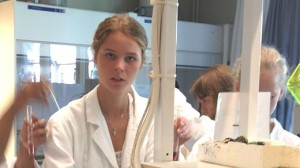 Science, technology, engineering and math (STEM) careers are fun, creative, innovative…and pay pretty well too. How do we get that message to pre-college students so they consider careers in STEM? How do we excite students, girls in particular, to explore how they can change the world and make it a better place through a STEM career? Through messaging, engaging experiences, role models and education, we can make a difference.
Science, technology, engineering and math (STEM) careers are fun, creative, innovative…and pay pretty well too. How do we get that message to pre-college students so they consider careers in STEM? How do we excite students, girls in particular, to explore how they can change the world and make it a better place through a STEM career? Through messaging, engaging experiences, role models and education, we can make a difference.
Messaging
The National Academy of Engineering’s recent study, “Changing the Conversation: Messages for Improving the Public Understanding of Engineering”, provides great insights into what motivates and interests pre-college students about technical fields. The research found that youth today have little understanding of what engineering is all about – engineers help people, but not directly, and are disconnected from people.
The good news is that less than 15 percent of the youth surveyed described engineers as nerdy or boring. Youth want well-paying jobs that make a difference and they believe engineering is a good career choice…just not for them.
We must change the language we use to describe our STEM professions. We must stop reinforcing the images of “nerdy and boring” when defining STEM careers if we want to recruit more students and especially more diverse students. We need to stop focusing on math and science as the required inputs – students know they must do well in math and science and we don’t need to emphasize it like we tend to do – and focus on the outputs, career opportunities and how STEM professionals make a difference in the world.
As engineers (and other STEM professionals), we create, innovate, imagine, discover, design, innovate and contribute. We are creative problem solvers, essential to the health, happiness and safety of our world’s citizens. We shape the future.
We must also change the images we use to describe our STEM professions. Girls are drawn to images of people, not things. We must stop creating images of the things of our professions – gears, gadgets, bridges, computers, cell phones, cars, etc. We must create the images of our profession using people – people communicating or collaborating using computers or cell phones or gadgets, people impacting the world using technology, people creating and innovating.
Engaging Experiences and Role Models
Engaging, hands-on STEM experiences where students can successfully design and create provide students the opportunity to gain confidence in their skills and allow them to consider the possibilities of pursuing STEM careers. Providing students opportunities to design and create and succeed – with role models, mentors close to their age and of the same gender, and experiences connected to real-world issues with an impact on society – can encourage both male and female students to consider STEM careers.
“Successful” engaging experiences are critical. Research has shown that how girls classify their success and failures is important in their career choice. Girls are more likely to attribute their successes to hard work (”I worked hard to successfully write that computer program.”) while they attribute their failures to their personal lack of ability (”My program didn’t work. I am no good at engineering.”).
Boys, on the other hand, attribute their successes to ability (”My computer program worked. I am good at writing programs.”) while attributing failures to external forces or lack of effort (”My program didn’t work. The professor didn’t give us good instructions.”). For girls in particular, providing role models who can share their experiences, show their career path, counter the “lack of ability” internal argument and generate excitement about their contribution to our world will open the eyes of our youth into the possibilities of a career in STEM.
Successful engaging experiences can take many forms and best practices abound in the research and published proceedings of the Women in Engineering ProActive Network (WEPAN) and the American Society for Engineering Education (ASEE). Team-based experiences, one-time short activities, long-term involved designs, faculty-led experiences, student-led activities – all are successful if they engage the student in the design and creation experience, provide a challenge, integrate the effective messaging, relate to real-world and societal impact, and allow for success in some form.
Education
As a profession, we must continue to educate the community about careers in STEM and the impact STEM has on our everyday lives and the health, happiness and security of our world. We must educate our teachers and counselors on the requirements for our profession and the benefits our profession provides to us as individuals and to our society. We must educate our coworkers and peers on the effective messaging research and encourage a changing of our language. And we must continually educate ourselves on the issues that impact the career choices of girls and the research and best practices in STEM field recruitment.
